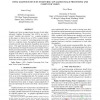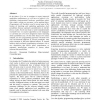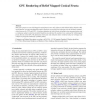292 search results - page 25 / 59 » Parallel Genetic Algorithms on Programmable Graphics Hardwar... |
SI3D
2005
ACM
14 years 1 months ago
2005
ACM
We present a simple yet effective snapping technique for constraining the motion of the cursor of an input device to the surface of 3D models whose geometry is arbitrarily deforme...
ISVC
2007
Springer
14 years 1 months ago
2007
Springer
Abstract. Floating mines are a significant threat to the safety of ships in theatres of military or terrorist conflict. Automating mine detection is difficult, due to the unpredict...
ICMCS
2008
IEEE
14 years 2 months ago
2008
IEEE
Graphics and vision are approximate inverses of each other: ordinarily Graphics Processing Units (GPUs) are used to convert “numbers into pictures” (i.e. computer graphics). I...
ACSC
2008
IEEE
14 years 2 months ago
2008
IEEE
In the future, if we are to continue to expect improved application performance we will have to achieve it by exploiting course-grained hardware parallelism rather then simply rel...
SIGGRAPH
1990
ACM
13 years 11 months ago
1990
ACM
This paper proposes to use relief-mapped conical frusta (cones cut by planes) to skin skeletal objects. Based on this representation, current programmable graphics hardware can pe...



